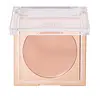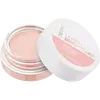What's inside
What's inside
 Key Ingredients
Key Ingredients

 Benefits
Benefits

 Concerns
Concerns

 Ingredients Side-by-side
Ingredients Side-by-side

Ricinus Communis Seed Oil
MaskingOctyldodecyl Stearoyl Stearate
EmollientBis-Diglyceryl Polyacyladipate-2
EmollientRhus Verniciflua Peel Wax
Rhus Succedanea Fruit Wax
Methyl Methacrylate Crosspolymer
Tribehenin
EmollientTocopherol
AntioxidantTocopheryl Acetate
AntioxidantGlycyrrhiza Glabra Root Extract
BleachingMicrocrystalline Wax
Emulsion StabilisingKaolin
AbrasiveTetrahexyldecyl Ascorbate
AntioxidantSilica
AbrasiveMontmorillonite
AbsorbentMagnesium Aluminum Silicate
AbsorbentCaffeine
Skin ConditioningSqualane
EmollientPolyethylene
AbrasiveEthylhexyl Palmitate
EmollientAtelocollagen
Skin ConditioningButylene Glycol
HumectantMica
Cosmetic ColorantPentaerythrityl Tetraisostearate
EmollientSilica Dimethyl Silylate
EmollientSodium Chondroitin Sulfate
Skin ConditioningSodium Hyaluronate
HumectantAscorbyl Palmitate
AntioxidantCaprylyl Glycol
EmollientPhenoxyethanol
PreservativeIron Oxides
CI 77891
Cosmetic ColorantRicinus Communis Seed Oil, Octyldodecyl Stearoyl Stearate, Bis-Diglyceryl Polyacyladipate-2, Rhus Verniciflua Peel Wax, Rhus Succedanea Fruit Wax, Methyl Methacrylate Crosspolymer, Tribehenin, Tocopherol, Tocopheryl Acetate, Glycyrrhiza Glabra Root Extract, Microcrystalline Wax, Kaolin, Tetrahexyldecyl Ascorbate, Silica, Montmorillonite, Magnesium Aluminum Silicate, Caffeine, Squalane, Polyethylene, Ethylhexyl Palmitate, Atelocollagen, Butylene Glycol, Mica, Pentaerythrityl Tetraisostearate, Silica Dimethyl Silylate, Sodium Chondroitin Sulfate, Sodium Hyaluronate, Ascorbyl Palmitate, Caprylyl Glycol, Phenoxyethanol, Iron Oxides, CI 77891
Pentaerythrityl Tetraisostearate
EmollientEthylhexyl Palmitate
EmollientMica
Cosmetic ColorantSorbitan Sesquioleate
EmulsifyingEuphorbia Cerifera Wax
Helianthus Annuus Seed Wax
Skin ConditioningSynthetic Fluorphlogopite
Tribehenin
EmollientDiisostearoyl Polyglyceryl-3 Dimer Dilinoleate
EmollientTapioca Starch
Butyrospermum Parkii Butter
Skin ConditioningBisabolol
MaskingTocopherol
AntioxidantHelianthus Annuus Seed Oil
EmollientRicinus Communis Seed Oil
MaskingSodium Hyaluronate
HumectantTocopheryl Acetate
AntioxidantAscorbyl Palmitate
AntioxidantHydrogenated Castor Oil
EmollientCI 77491
Cosmetic ColorantCI 77492
Cosmetic ColorantCI 77499
Cosmetic ColorantCI 77891
Cosmetic ColorantPentaerythrityl Tetraisostearate, Ethylhexyl Palmitate, Mica, Sorbitan Sesquioleate, Euphorbia Cerifera Wax, Helianthus Annuus Seed Wax, Synthetic Fluorphlogopite, Tribehenin, Diisostearoyl Polyglyceryl-3 Dimer Dilinoleate, Tapioca Starch, Butyrospermum Parkii Butter, Bisabolol, Tocopherol, Helianthus Annuus Seed Oil, Ricinus Communis Seed Oil, Sodium Hyaluronate, Tocopheryl Acetate, Ascorbyl Palmitate, Hydrogenated Castor Oil, CI 77491, CI 77492, CI 77499, CI 77891
Ingredients Explained
These ingredients are found in both products.
Ingredients higher up in an ingredient list are typically present in a larger amount.
Ascorbyl Palmitate is created by combining pure Vitamin C and palmitic acid. It is an antioxidant and helps reduce hyperpigmentation.
This ingredient is a more stable version of Vitamin C, meaning it does not disintegrate as quickly when exposed to sunlight. However, studies show it does not penetrate skin as well as pure Vitamin C.
Ascorbyl Palmitate is oil soluble.
Read more about other types of Vitamin C:
Learn more about Ascorbyl PalmitateCi 77891 is a white pigment from Titanium dioxide. It is naturally found in minerals such as rutile and ilmenite.
It's main function is to add a white color to cosmetics. It can also be mixed with other colors to create different shades.
Ci 77891 is commonly found in sunscreens due to its ability to block UV rays.
Learn more about CI 77891Ethylhexyl Palmitate, also known as octyl palmitate, is created from 2-ethylhexyl alcohol and palmitic acid. It is a fatty acid ester.
The fatty acid content of Ethylhexyl Palmitate makes it an emollient. Emollients help soften and hydrate your skin by trapping moisture within.
Ethylhexyl Palmitate is also used to help improve the texture of cosmetics. It helps other ingredient dissolve in products and help disperse ingredients more evenly.
You'll likely find this ingredient in sunscreen, as it is often used to mix UV-blocking ingredients such as avobenzone and ethylhexyl triazone.
It can also help stabilize the fragrances in a product as a fragrance fixative.
Ethylhexyl Palmitate can be used to substitute mineral oil.
Due to its high fatty acid content, it may not be fungal-acne safe.
Learn more about Ethylhexyl PalmitateMica is a naturally occurring mineral used to add shimmer and color in cosmetics. It can also help improve the texture of a product or give it an opaque, white/silver color.
Serecite is the name for very fine but ragged grains of mica.
This ingredient is often coated with metal oxides like titanium dioxide. Trace amounts of heavy metals may be found in mica, but these metals are not harmful in our personal products.
Mica has been used since prehistoric times throughout the world. Ancient Egyptian, Indian, Greek, Roman, Aztec, and Chinese civilizations have used mica.
Learn more about MicaPentaerythrityl Tetraisostearate is derived from isostearic acid. It is an emollient and emulsifier.
The highest concentration of this ingredient is found in lipsticks.
This ingredient is minimally water soluble and may not be Malassezia folliculitis, or fungal-acne safe.
Learn more about Pentaerythrityl TetraisostearateRicinus Communis Seed Oil is the INCI name for castor oil.
Castor Oil helps moisturize the skin. It is rich in a fatty acid called ricinoleic acid. This fatty acid helps prevent moisture loss on the skin. This helps keep your skin soft and hydrated. Ricinoleic acid also has anti-inflammatory and pain reducing properties.
Besides hydrating the skin, castor oil is also used to hydrate hair. By keeping the hair shaft moisturized, breakage is decreased. More studies are needed to show castor oil's effective on stimulating hair growth.
Castor oil is created by cold-pressing castor seeds and then purifying the oil with heat. It was used in Ancient Egypt as fuel in lamps and to help treat eye irritation.
The term 'fragrance' is not regulated in many countries. In many cases, it is up to the brand to define this term. For instance, many brands choose to label themselves as "fragrance-free" because they are not using synthetic fragrances. However, their products may still contain ingredients such as essential oils that are considered a fragrance.
Learn more about Ricinus Communis Seed OilSodium Hyaluronate is hyaluronic acid's salt form. It is commonly derived from the sodium salt of hyaluronic acid.
Like hyaluronic acid, it is great at holding water and acts as a humectant. This makes it a great skin hydrating ingredient.
Sodium Hyaluronate is naturally occurring in our bodies and is mostly found in eye fluid and joints.
These are some other common types of Hyaluronic Acid:
Learn more about Sodium HyaluronateTocopherol (also known as Vitamin E) is a common antioxidant used to help protect the skin from free-radicals and strengthen the skin barrier. It's also fat soluble - this means our skin is great at absorbing it.
Vitamin E also helps keep your natural skin lipids healthy. Your lipid skin barrier naturally consists of lipids, ceramides, and fatty acids. Vitamin E offers extra protection for your skin’s lipid barrier, keeping your skin healthy and nourished.
Another benefit is a bit of UV protection. Vitamin E helps reduce the damage caused by UVB rays. (It should not replace your sunscreen). Combining it with Vitamin C can decrease sunburned cells and hyperpigmentation after UV exposure.
You might have noticed Vitamin E + C often paired together. This is because it is great at stabilizing Vitamin C. Using the two together helps increase the effectiveness of both ingredients.
There are often claims that Vitamin E can reduce/prevent scarring, but these claims haven't been confirmed by scientific research.
Learn more about TocopherolTocopheryl Acetate is AKA Vitamin E. It is an antioxidant and protects your skin from free radicals. Free radicals damage the skin by breaking down collagen.
One study found using Tocopheryl Acetate with Vitamin C decreased the number of sunburned cells.
Tocopheryl Acetate is commonly found in both skincare and dietary supplements.
Learn more about Tocopheryl AcetateTribehenin comes from glycerin and behenic acid.
It is used as an emollient, or moisturizer. Emollients form a thin barrier on skin to prevent moisture from escaping.
This ingredient may not be Malassezia folliculitis, or fungal-acne safe.
Learn more about Tribehenin